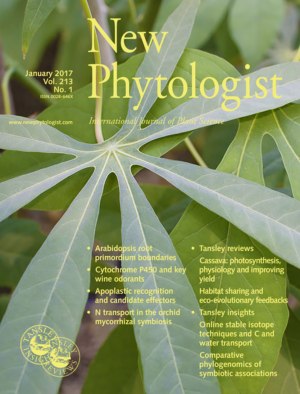DOI: 10.1111/nph.14250
Rooting for cassava: insights into photosynthesis and associated physiology as a route to improve yield potential
Abstract
 As a consequence of an increase in world population, food demand is expected to grow by up to 110% in the next 30–35 yr. The population of sub-Saharan Africa is projected to increase by > 120%. In this region, cassava (Manihot esculenta) is the second most important source of calories and contributes c. 30% of the daily calorie requirements per person. Despite its importance, the average yield of cassava in Africa has not increased significantly since 1961. An evaluation of modern cultivars of cassava showed that the interception efficiency (ɛi) of photosynthetically active radiation (PAR) and the efficiency of conversion of that intercepted PAR (ɛc) are major opportunities for genetic improvement of the yield potential. This review examines what is known of the physiological processes underlying productivity in cassava and seeks to provide some strategies and directions toward yield improvement through genetic alterations to physiology to increase ɛi and ɛc. Possible physiological limitations, as well as environmental constraints, are discussed.
As a consequence of an increase in world population, food demand is expected to grow by up to 110% in the next 30–35 yr. The population of sub-Saharan Africa is projected to increase by > 120%. In this region, cassava (Manihot esculenta) is the second most important source of calories and contributes c. 30% of the daily calorie requirements per person. Despite its importance, the average yield of cassava in Africa has not increased significantly since 1961. An evaluation of modern cultivars of cassava showed that the interception efficiency (ɛi) of photosynthetically active radiation (PAR) and the efficiency of conversion of that intercepted PAR (ɛc) are major opportunities for genetic improvement of the yield potential. This review examines what is known of the physiological processes underlying productivity in cassava and seeks to provide some strategies and directions toward yield improvement through genetic alterations to physiology to increase ɛi and ɛc. Possible physiological limitations, as well as environmental constraints, are discussed.